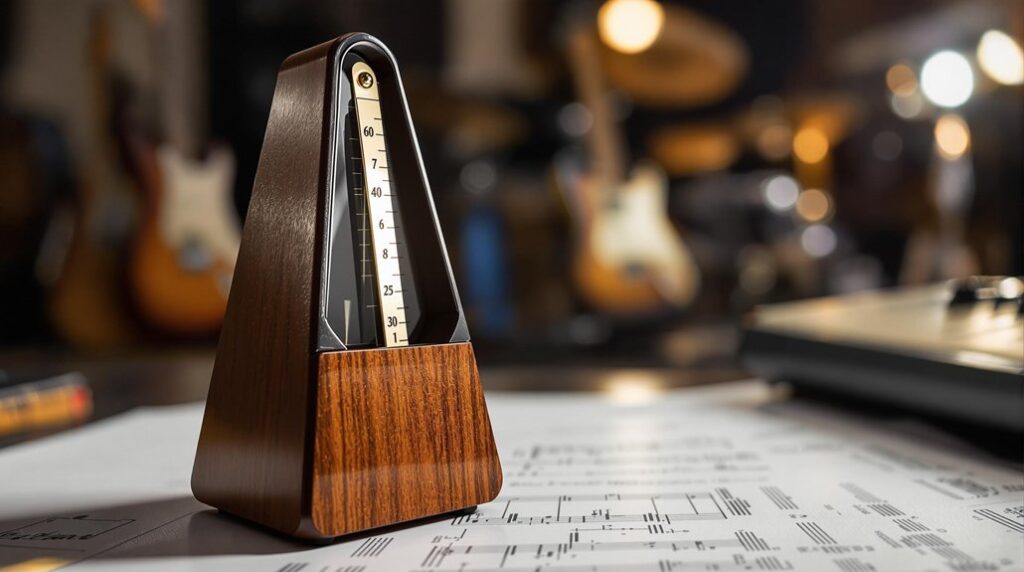Enhance your improvisation by mastering the eight essentials of basic music theory. Start with understanding harmony, where chords like majors and minors form the backbone of music’s emotional impact. Explore the art of melody, recognizing how sequences of notes convey a composition’s soul. Decode music scales, including major and minor, to navigate various key signatures. Grasp chords’ roles in forming harmonic structures and shifts. Basics of counterpoint enrich textures by intertwining independent melodies. Investigate rhythm and syncopation for dynamic rhythms and accents, vital for jazz. Finally, actively integrate these principles to enrich your improvisational repertoire, enhancing your creative journey.
Key Takeaways
- Master I-IV-V-I progressions to enhance melodic development and harmonic understanding.
- Utilize major and minor scales to influence emotional tone and enrich improvisation.
- Practice syncopation and rhythmic complexity for engaging and dynamic performances.
- Explore chord inversions and voice leading for smoother transitions in improvisation.
- Experiment with modes and tonalities to encourage creative expression and depth in solos.
Understanding Harmony
Harmony, an integral component of music theory, involves the simultaneous combination of different musical notes to produce soundscapes that can be either consonant, evoking a sense of pleasure, or dissonant, creating tension.
At the heart of harmony are chords, which form the fundamental building blocks. These chords, categorized as major, minor, diminished, and augmented, are constructed from a root note.
The relationship between these chords is articulated through chord progressions, a sequential arrangement that supports melodies and rhythms. Utilizing Roman numeral analysis, musicians can discern chord functions within a key, enhancing their harmonic understanding.
Additionally, chord inversions, which alter the bass note while maintaining the chord structure, offer smoother shifts and enrich the harmonic texture. Understanding common progression patterns is essential for creating emotional resonance in your music.
Exploring Melody
How does one define the essence of a melody in music? A melody is a sequence of notes forming a musical phrase, often recognized as the soul of a composition. It is characterized by pitch, which determines how high or low a note sounds, and rhythm, which dictates the timing and duration of notes.
Melodies may move stepwise with small intervals or leap with larger ones, adding variety and intrigue. Consider Beethoven’s “Ode to Joy,” where the melody’s stepwise motion creates a sense of familiarity and comfort.
Variations like repetition, sequence, and embellishment enhance a melody’s emotional impact, making it memorable. Mastery of melody involves understanding these elements, allowing musicians to create compelling and expressive musical narratives. Furthermore, the interplay of melody with harmony and rhythm enriches the overall musical experience, deepening the listener’s connection to the piece.
Decoding Music Scales
Music scales form the foundational framework upon which melodies and harmonies are constructed. These scales are a set of notes arranged in a sequence of ascending or descending order and include eight notes within an octave.
Major scales, recognized by their bright and happy sound, follow the pattern of whole (W) and half (H) steps: W-W-H-W-W-W-H. Alternatively, minor scales create a melancholic tone with the pattern W-H-W-W-H-W-W.
There are twelve natural major and minor scales, each essential for understanding key signatures and harmonies. In addition, seven modes can be derived from a parent scale, offering unique tonal qualities.
These modes enrich improvisation and composition by introducing diverse emotional expressions, thereby expanding a musician’s creative palette. Understanding key signatures is crucial for effectively utilizing these scales in musical performance and composition.
Chords and Their Roles
Chords, the harmonic backbone of music, come in various types, with triads—consisting of a root, third, and fifth—being among the most fundamental.
Major and minor chords shape the emotional terrain of a composition, with major chords imparting a bright sound and minor chords introducing a more melancholic tone.
Techniques in chord progression, such as the classic I-IV-V-I sequence, establish a song’s harmonic structure, guiding the melody and creating a cohesive musical narrative. Understanding key modulation can also enhance the emotional impact of chord progressions, allowing for dynamic shifts throughout a piece.
Types of Chords
The foundation of harmony in music is built upon the various types of chords, each serving a unique role in creating musical texture and emotion. At the core are triads, comprising three notes: major, minor, diminished, and augmented. These types of chords form the basic structure and convey distinct moods—major chords sound bright and happy, while minor chords evoke a somber tone.
Expanding on triads, seventh chords add depth with a fourth note, offering variations like major seventh and dominant seventh, which enrich harmonic possibilities. Additionally, chord inversions alter the bass note, providing smoother shifts and varied soundscapes.
Understanding these chord types is essential for musicians aiming to craft compelling, dynamic musical pieces.
Chord Progression Techniques
Building on the understanding of chord types, the art of crafting chord progressions becomes the next focus for musicians aiming to enrich their compositions.
Chord progressions are structured sequences that enhance melody and rhythm, with the classic I-IV-V-I pattern serving as a foundational example. Analyzing progressions using Roman numerals clarifies their roles within a key, highlighting harmonic relationships.
Triads, comprising major, minor, diminished, and augmented chords, are the essential elements for constructing these progressions. Chord inversions, which rearrange the bass note, facilitate smoother shifts and variety.
Introducing seventh chords—major, minor, dominant, diminished, and half-diminished—further enriches the harmonic setting. These techniques collectively enable musicians to craft dynamic, engaging chord progressions that captivate and sustain listener interest.
Basics of Counterpoint
Harmony emerges from the intricate interplay of independent melodies, a technique known as counterpoint. This musical practice involves the fusion of melodic lines to create harmonious textures, enriching compositions with depth.
Counterpoint is an essential study for musicians, offering insights into voice leading and the balance between consonance and dissonance. There are two primary types:
- Species Counterpoint: This structured approach consists of five forms, each increasing in complexity, guiding composers in mastering melodic interaction.
- Free Counterpoint: Allows for greater melodic freedom, encouraging creative exploration within harmonic frameworks.
- Historical Application: Johann Sebastian Bach’s extensive use of counterpoint in his compositions exemplifies its significance in Western classical music, making it a fundamental tool for aspiring musicians to explore and develop their craft. Understanding rhythm basics enhances the effectiveness of counterpoint by allowing musicians to better integrate their melodic lines with underlying beats.
Rhythm and Syncopation
In the domain of music theory, mastering rhythm and syncopation is fundamental, particularly in jazz where syncopation techniques play a pivotal role in creating the characteristic “swing” feel.
By placing accents on weaker beats, musicians introduce rhythmic complexity into their improvisations, crafting unexpected phrasing that captivates audiences.
For instance, the iconic off-beat accents in Gershwin’s “I Got Rhythm” exemplify how syncopation can transform a simple melody into a dynamic and engaging performance. Additionally, understanding time signatures allows musicians to explore various rhythmic possibilities, further enhancing their improvisational skills.
Jazz Syncopation Techniques
Though often challenging to master, syncopation is an indispensable component of jazz rhythm that breathes life and dynamism into performances. By placing accents on weak beats or offbeats, musicians create a sense of surprise and swing, essential for a fascinating jazz improvisation.
This technique involves rests and ties, introducing rhythmic complexity that enhances solos and shapes the groove, influencing the piece’s feel and energy. Mastering syncopation allows musicians to improvise with greater freedom and creativity, fostering a unique performance style.
Consider these syncopation techniques to enhance your jazz playing:
- Offbeat Accents: Emphasize unexpected beats to create intrigue.
- Use of Rests: Introduce pauses to add rhythmic tension.
- Tied Notes: Connect notes across beats for a flowing, syncopated rhythm.
Rhythmic Complexity in Improvisation
As musicians explore the realm of jazz improvisation, understanding and utilizing rhythmic complexity becomes essential. Syncopation, a key element, introduces unexpected accents that enhance the musical experience. By incorporating rhythmic variations like off-beat notes, musicians add tension and interest, moving away from predictable patterns. The use of triplets and dotted notes enriches rhythmic expression, allowing for diverse textures.
Practicing different rhythmic patterns is vital for developing timing and coordination. Mastery of swing rhythm, with its laid-back feel, is indispensable for transforming the groove of a piece. Consider the following elements:
| Technique | Effect | Example |
|---|---|---|
| Syncopation | Unexpected accents | Off-beat notes |
| Triplets | Diverse textures | 3 notes per beat |
| Dotted Notes | Enriched expression | Longer note value |
| Swing Rhythm | Laid-back groove | Jazz walking bass |
| Rhythmic Practice | Timing/Coordination | Metronome exercises |
These techniques collectively foster rhythmic complexity in improvisation.
Accents and Unexpected Phrasing
Building upon the rhythmic complexity explored in jazz improvisation, the concepts of accents and unexpected phrasing introduce an additional layer of depth to musical expression. Accents emphasize specific beats or notes, adding surprise and enhancing rhythmic interest.
Syncopation, a common jazz technique, places accents on weak or off-beats, disrupting the expected flow and creating a unique groove. This technique is essential for shaping jazz’s distinctive sound, altering listener anticipation and engagement.
To effectively incorporate these elements:
- Practice Syncopation: Develop timing and flexibility by experimenting with syncopated rhythms.
- Break Patterns: Use unexpected phrasing to break standard rhythmic patterns, adding dynamism to performances.
- Emphasize Accents: Focus on strategically placed accents to enhance musical phrases and maintain listener interest.
Improvisation Techniques
Improvisation techniques in music provide a framework for creativity, allowing musicians to explore and express their unique artistic voice.
The Funky Scale Method introduces scales through improvisation, encouraging musicians to experiment with different tonalities and expand their creative expression. Mastery of scales such as the Natural Minor and Minor Pentatonic is essential, as these provide a solid foundation for developing melodies during improvisation.
Rhythm and coordination-focused methods further enhance dynamic performance capabilities, offering musicians tools to craft engaging musical narratives.
Meanwhile, the Blues Scale masterclass emphasizes incorporating emotional depth into improvisational phrases by exploring modes. Understanding the emotional impact of minor scales is key to effective improvisation, enhancing the depth and resonance of the performance.
Structured mini-improv exercises, inspired by classical geniuses, guide creativity and exploration, ultimately refining overall improvisational skills within a supportive framework.
Integrating Music Theory
Understanding music theory is essential for musicians seeking to enhance their improvisational skills, as it provides a robust framework for crafting harmonically rich solos.
By integrating music theory into improvisation, musicians can deepen their understanding of chord structures and explore creative opportunities.
Here are three key strategies:
- Explore Scales and Chord Progressions: Mastery of scales and their corresponding chord progressions, like I-IV-V-I, offers a foundation for developing melodies and achieving improvisational freedom.
- Practice Voice Leading and Inversions: This enhances smoother shifts and adds dynamism to your passages, enriching the improvisational experience.
- Transcribe and Analyze Solos: Regularly studying solos from accomplished musicians aids in translating theoretical concepts into practice.
These techniques foster a thorough understanding of music theory, aiding in the creation of more expressive and nuanced improvisations. Additionally, familiarity with major and minor scales can significantly influence the emotional tone of your improvisations.
Frequently Asked Questions
What Is a Perfect 8 Music Theory?
A Perfect 8, or octave, is a perfect interval characterized by a frequency doubling, creating identical note names across registers. It spans 12 half steps, integral for constructing scales, chords, and establishing tonal centers in music.
What Is Grade 8 Music Theory?
Grade 8 Music Theory represents the pinnacle of theoretical music education, encompassing advanced composition techniques, intricate counterpoint, and modulation. It requires students to master complex musical forms, enhancing their ability to interpret, compose, and analyze sophisticated musical pieces.
Is Music Theory the Hardest AP Class?
AP Music Theory is considered among the more challenging AP courses due to its demanding curriculum, encompassing complex concepts like harmony and rhythm. Its difficulty lies in the necessity for both theoretical understanding and practical application, enhancing musical proficiency.
What Are the 12 Keys in Music Theory?
The 12 keys in music theory are based on the chromatic scale’s 12 pitches. Each key, with specific key signatures, can be either major or minor, creating unique tonal atmospheres, and facilitating diverse musical expressions and improvisations.
Conclusion
To enhance improvisational skills, a thorough understanding of basic music theory is essential. Harmony and melody provide the foundational elements, while decoding scales and understanding chords offer insight into musical structure. Counterpoint introduces the interplay of independent melodies, and rhythm with syncopation adds dynamic variation. Effective improvisation techniques rely on these principles, allowing musicians to create spontaneously. Integrating these aspects of music theory fosters creativity and enhances the ability to craft engaging and expressive musical performances.




